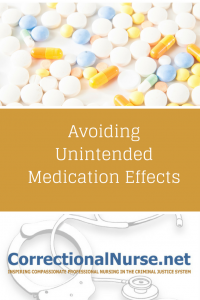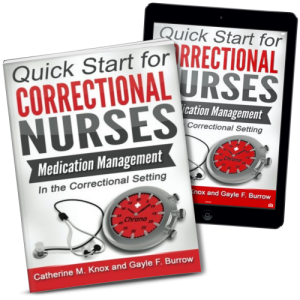 A 63-year-old man is screened in booking. The intake nurse takes his blood pressure and finds it high at 180/98. He tells her he is on blood pressure medication and provides the name of his pharmacy. Verification identifies that his last prescription was for 40mg of Lisinopril daily. Since he stated he had not taken his medication that day, she provides a dose from stock after obtaining continuation orders from the provider on call. The medication order is transcribed and he begins daily dosing during pill line. Several days later, he is brought to sick call feeling light-headed and unsteady. Now his blood pressure is 90/50. What happened?
A 63-year-old man is screened in booking. The intake nurse takes his blood pressure and finds it high at 180/98. He tells her he is on blood pressure medication and provides the name of his pharmacy. Verification identifies that his last prescription was for 40mg of Lisinopril daily. Since he stated he had not taken his medication that day, she provides a dose from stock after obtaining continuation orders from the provider on call. The medication order is transcribed and he begins daily dosing during pill line. Several days later, he is brought to sick call feeling light-headed and unsteady. Now his blood pressure is 90/50. What happened?
Often a verified, community-based dosage is too high for administration during incarceration because the provider in the community was not aware that the patient was not taking the medication as prescribed. Now that the person is in custody, they develop symptoms of over-medication because their medication is now taken consistently. Jeff Keller, a well-known correctional physician calls this the “Compliance Trap” and advises that we all need to be wary of this potential risk.
According to the World Health Organization (WHO), approximately 50% of patients with chronic illness do not take medications as prescribed; other studies have found compliance to be even less. This is also a problem in correctional settings. Correctional nurses need to know the signs and symptoms of conditions that indicate an unintended side effect or adverse reaction to medication, especially those common to patients being treated in correctional settings. When these symptoms develop, the nurse is most likely to see the patient first, identify the problem, initiate prompt treatment, and follow-up with the patient. Common effects and reactions are listed below.
- Allergic reaction or anaphylaxis: Drugs most often associated with allergic reactions include anticonvulsants, insulin (animal sourced), penicillin and related antibiotics, sulfa drugs, vaccines, and iodine-based x-ray contrast dyes. Anaphylaxis is a medical emergency, and the facility should have a written protocol that is used to initiate treatment.
- Heat exhaustion and heat stroke: Environmental conditions and institution rules can put inmates at risk of heat exhaustion and stroke because individuals can not regulate the temperature in their cell, or may be required to work outside is required when the temperature is high, or may have limited access to water. Individuals taking psychotropic medication, diuretics, antiparkinsonian or anticholinergic medication, amphetamines, and beta blockers are particularly at risk. Correctional facilities typically have an established policy and practice to prevent heat exhaustion and stroke. If your facility does not have one, use this resource and/or contact other correctional facilities and ask for a copy to adapt to your site.
- Photosensitivity: Similar to heat exhaustion, inmates often cannot control their exposure to light and, if taking certain medications, may experience extreme sunburn or urticarial reactions. A list of these medications and tips on prevention and treatment is provided in an article published by the Institute for Safe Medication Practices (IMSP) that is listed on the resources page.
- Hyponatremia: This is a condition identified by low sodium levels and can be caused by several triggers, including certain medications (e.g. SSRIs, haloperidol, MAO inhibitors, diuretics, some chemotherapeutic agents, chlorpropamide, and use of IVs). Treatment will depend on the likely cause and may include water restriction, electrolyte monitoring, and vital sign monitoring.
- Complications from psychotropic medication: Extrapyramidal symptoms, tardive dyskinesia, serotonin syndrome, lithium toxicity, neuroleptic malignant syndrome, and metabolic syndrome are each complications of treatment with psychotropic medications. Unless you were a psychiatric nurse before transferring to corrections, you are probably not familiar with any of these. Because more than one-half the population in correctional settings have mental health problems, all correctional nurses must be familiar with the assessment and treatment of psychiatric disorders, including the medications, the side effects, and adverse reactions. Contact the facility psychiatrist, nurse practitioner, or physician’s assistant for their help to increase your knowledge in this area, especially if mental health nursing is new to you.
Have you had a situation similar to the case described here? Share your thoughts and experiences in the comments section of this post.
 This information comes from the book “Medication Management in the Correctional Setting” , a Quick Start for Correctional Nurses written by Catherine M. Knox and Gayle F. Burrow. Learn more about the book here.
This information comes from the book “Medication Management in the Correctional Setting” , a Quick Start for Correctional Nurses written by Catherine M. Knox and Gayle F. Burrow. Learn more about the book here.
Leave a Reply